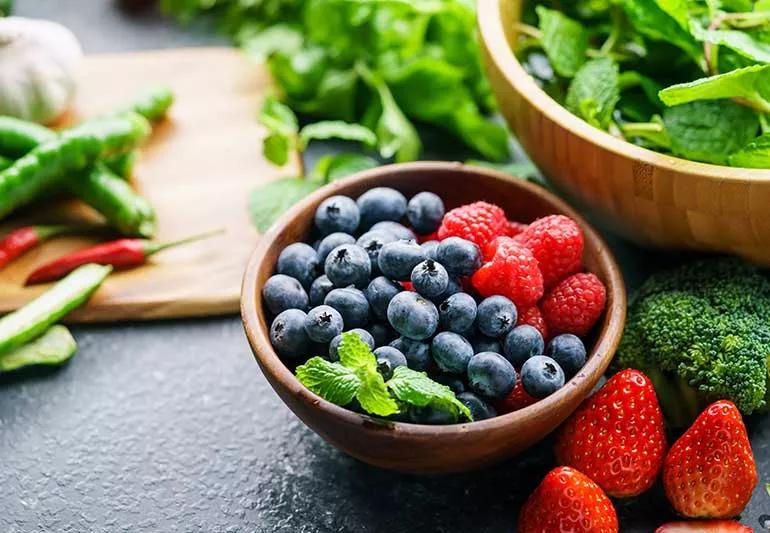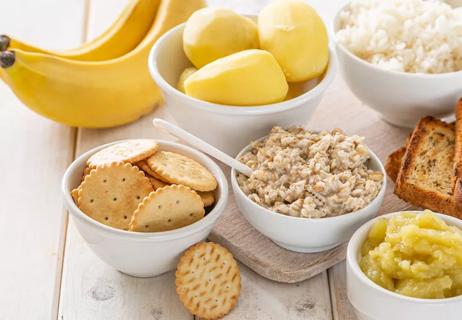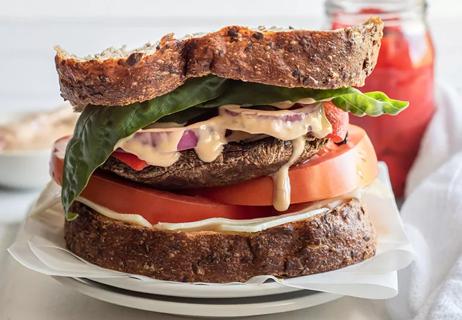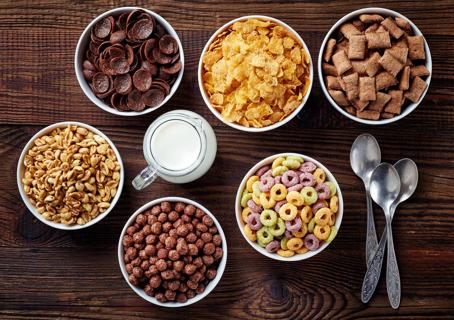Different symptoms call for different menus

Eating is often the last thing you feel like doing when you have an upset stomach, but it might be what you need. Reaching for the right snack could help ease your discomfort.
Advertisement
Cleveland Clinic is a non-profit academic medical center. Advertising on our site helps support our mission. We do not endorse non-Cleveland Clinic products or services. Policy
But making the right food choice when your tummy is topsy-turvy often depends on your symptoms and what’s causing them. Different issues such as nausea, constipation, cramping or diarrhea call for different food solutions.
So, what should you eat and not eat when your stomach doesn’t feel tip-top? Gastroenterologist Christine Lee, MD, has some suggestions.
“Upset stomach” is an umbrella term that covers all types of abdominal discomfort and changes in bowel movements. But different symptoms require different foods:
Constipation (when you can’t have a bowel movement) is frustrating. But it can also cause a chain reaction in your gut.
“Constipation almost always goes hand in hand with bloating and gas, which result from all the pressure that builds up,” Dr. Lee explains. “To relieve all three symptoms, stick with foods that help you go.”
When you need help going, fiber is your best friend. Soluble fiber breaks down in the digestive tract and acts as a natural stool softener. This helps bowel movements along and eases constipation.
Foods high in soluble fiber include:
Advertisement
Food also can include insoluble fiber that moves through your digestive tract without breaking down. It is found in foods like leafy greens, dried fruit and nuts.
Avoid foods that are overly processed and low in fiber, such as:
When foods seem to move right through you, it isn’t easy to imagine that eating more would help. But the BRAT diet involves easily digested foods that are gentle on your GI tract. BRAT is an acronym for:
“The BRAT diet is especially helpful if diarrhea happens while traveling,” Dr. Lee notes. “If you do not have access to medicine or medical care near you, you can seek out these and gentle foods to ease an upset stomach.”
Sticking to the BRAT diet for a day or two may help relieve diarrhea, even if the cause is food poisoning or stomach flu. But because a wide variety of foods is important for healthy living, it’s not a diet you should adopt full-time.
To avoid making diarrhea worse, stay away from:
Nausea is a common symptom associated with many conditions — some more serious than others. If your nausea is ongoing and you don’t know why, get checked out by a healthcare provider.
“The treatment for different causes of nausea can vary greatly,” Dr. Lee says. “Sometimes, it’s better to give your stomach a rest. Other times, we recommend oral hydration with a sports drink or electrolyte drink.”
But if you can pinpoint the cause of your nausea (like pregnancy or cancer treatment), you can cautiously eat something to help settle your stomach. Start with the BRAT diet, as it’s bland.
A natural food for an upset stomach — specifically pregnancy-related nausea and vomiting — may be ginger. Researchers found that pregnant people experienced five times less nausea and vomiting by eating a small amount (less than 1 gram) of ginger every day for four days.
“The best thing you can do is listen to your body,” Dr. Lee advises. “Your body will clue you in and help you out if you truly can’t keep anything down. If you try to take a sip of a sports drink and it immediately causes nausea, your body is telling you that you can’t tolerate it. That’s when you know you need to get to your healthcare provider.”
Stomach cramping and sharp pains can be signs of another issue, such as bowel problems, approaching menstruation or an acute condition like appendicitis.
If you get cramps every month before your period, consider keeping a log. You might be able to ward them off by making small changes to your diet before cramping sets in.
Advertisement
“Be proactive if you always get stomach pain around the time your period arrives,” Dr. Lee advises. A high-fiber, low-fat diet can lower inflammation and levels of estrogen (the hormone responsible for menstrual cramping).
When you’re expecting cramps, choose foods such as:
Try to avoid:
Dr. Lee recommends seeking urgent care if you have alarming symptoms in addition to cramping and pain, or if the pain is sharp and increasing in frequency, intensity or duration.
“When in doubt, check it out,” she says. “No one knows your body better than you. Don’t accept that any ongoing stomach upset is just your new norm. Whether you see your primary care provider or a GI provider, we can check it out and treat the issue.”
| Stomach issue | Foods to eat | Foods to avoid |
|---|---|---|
| Constipation | Vegetables. Fruits. Prune juice. Apple juice. Quinoa. Whole grains. | Fast food. Frozen meals. Packaged snacks. |
| Diarrhea | Bananas. Rice (white). Applesauce. Toast (white). | Acidic fruits. Alcohol. Caffeine. Dairy products. Fried/spicy food. Sugar. |
| Nausea and vomiting | Sports drinks. Electrolyte drinks. Ginger. | Non-bland food. |
| Cramps | Beans. Fruit. Metamucil. Prune juice. Vegetables. Whole grains. | Animal products. Fatty food. Processed food. Refined grains. |
| Stomach issue | ||
| Constipation | ||
| Foods to eat | ||
| Vegetables. Fruits. Prune juice. Apple juice. Quinoa. Whole grains. | ||
| Foods to avoid | ||
| Fast food. Frozen meals. Packaged snacks. | ||
| Diarrhea | ||
| Foods to eat | ||
| Bananas. Rice (white). Applesauce. Toast (white). | ||
| Foods to avoid | ||
| Acidic fruits. Alcohol. Caffeine. Dairy products. Fried/spicy food. Sugar. | ||
| Nausea and vomiting | ||
| Foods to eat | ||
| Sports drinks. Electrolyte drinks. Ginger. | ||
| Foods to avoid | ||
| Non-bland food. | ||
| Cramps | ||
| Foods to eat | ||
| Beans. Fruit. Metamucil. Prune juice. Vegetables. Whole grains. | ||
| Foods to avoid | ||
| Animal products. Fatty food. Processed food. Refined grains. |
Advertisement
Learn more about our editorial process.
Advertisement

Help your aching belly by staying hydrated, eating bland foods and avoiding certain foods

Hunger is the obvious cause, but food quality, and lack of protein and water are also key

How to tell if it's something more serious

Find out why some foods seem to expand your waistline

Best advice from a GI expert

A satisfying veggie option with a kick

There are better breakfast options, but if it’s got to be cereal, look for whole grains, high fiber and no added sugar

If the flakes are undisturbed, pristine white and come from the top layer, it’s typically safe to indulge in a scoop

Type 2 diabetes isn’t inevitable with these dietary changes

Applying a hot or cold compress can help with pain